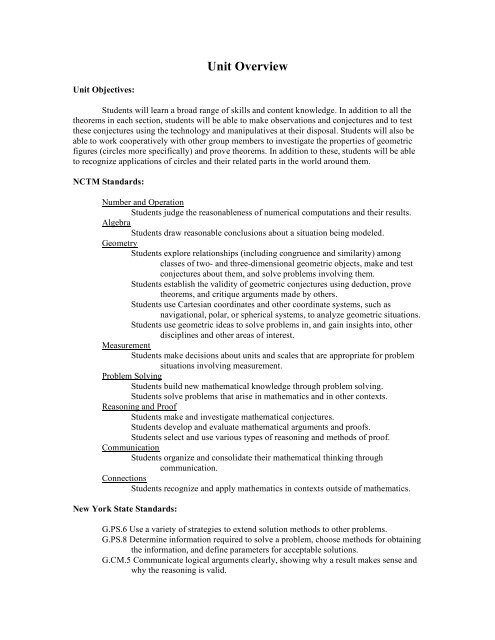The Geometry of a Circle - By: Dennis Kapatos
The Geometry of a Circle - By: Dennis Kapatos
The Geometry of a Circle - By: Dennis Kapatos
Create successful ePaper yourself
Turn your PDF publications into a flip-book with our unique Google optimized e-Paper software.
Unit Overview<br />
Unit Objectives:<br />
Students will learn a broad range <strong>of</strong> skills and content knowledge. In addition to all the<br />
theorems in each section, students will be able to make observations and conjectures and to test<br />
these conjectures using the technology and manipulatives at their disposal. Students will also be<br />
able to work cooperatively with other group members to investigate the properties <strong>of</strong> geometric<br />
figures (circles more specifically) and prove theorems. In addition to these, students will be able<br />
to recognize applications <strong>of</strong> circles and their related parts in the world around them.<br />
NCTM Standards:<br />
Number and Operation<br />
Students judge the reasonableness <strong>of</strong> numerical computations and their results.<br />
Algebra<br />
Students draw reasonable conclusions about a situation being modeled.<br />
<strong>Geometry</strong><br />
Students explore relationships (including congruence and similarity) among<br />
classes <strong>of</strong> two- and three-dimensional geometric objects, make and test<br />
conjectures about them, and solve problems involving them.<br />
Students establish the validity <strong>of</strong> geometric conjectures using deduction, prove<br />
theorems, and critique arguments made by others.<br />
Students use Cartesian coordinates and other coordinate systems, such as<br />
navigational, polar, or spherical systems, to analyze geometric situations.<br />
Students use geometric ideas to solve problems in, and gain insights into, other<br />
disciplines and other areas <strong>of</strong> interest.<br />
Measurement<br />
Students make decisions about units and scales that are appropriate for problem<br />
situations involving measurement.<br />
Problem Solving<br />
Students build new mathematical knowledge through problem solving.<br />
Students solve problems that arise in mathematics and in other contexts.<br />
Reasoning and Pro<strong>of</strong><br />
Students make and investigate mathematical conjectures.<br />
Students develop and evaluate mathematical arguments and pro<strong>of</strong>s.<br />
Students select and use various types <strong>of</strong> reasoning and methods <strong>of</strong> pro<strong>of</strong>.<br />
Communication<br />
Students organize and consolidate their mathematical thinking through<br />
communication.<br />
Connections<br />
Students recognize and apply mathematics in contexts outside <strong>of</strong> mathematics.<br />
New York State Standards:<br />
G.PS.6 Use a variety <strong>of</strong> strategies to extend solution methods to other problems.<br />
G.PS.8 Determine information required to solve a problem, choose methods for obtaining<br />
the information, and define parameters for acceptable solutions.<br />
G.CM.5 Communicate logical arguments clearly, showing why a result makes sense and<br />
why the reasoning is valid.

















